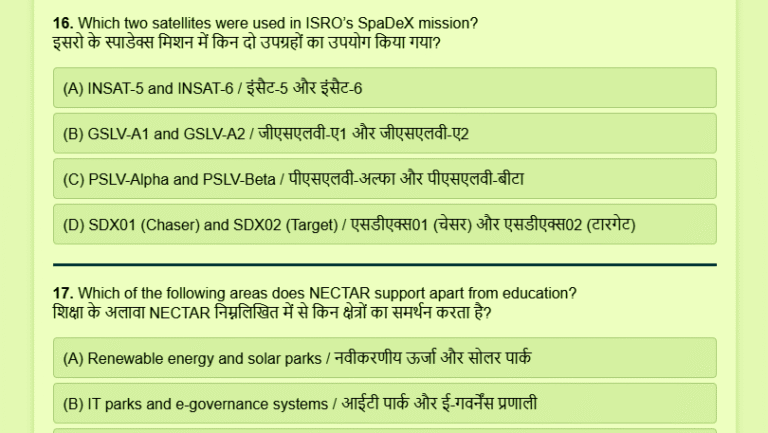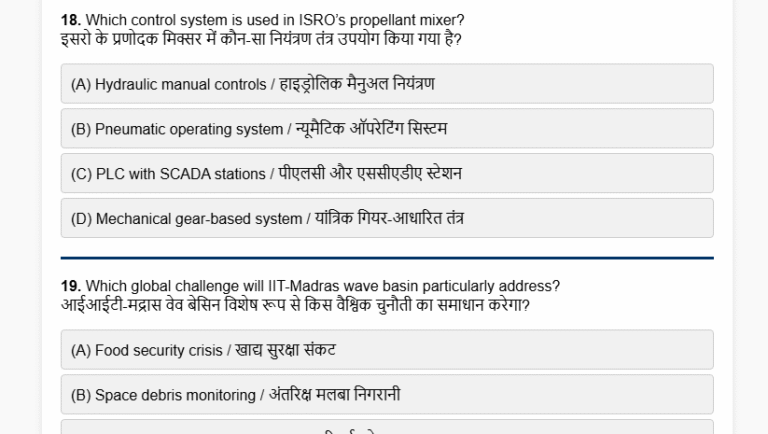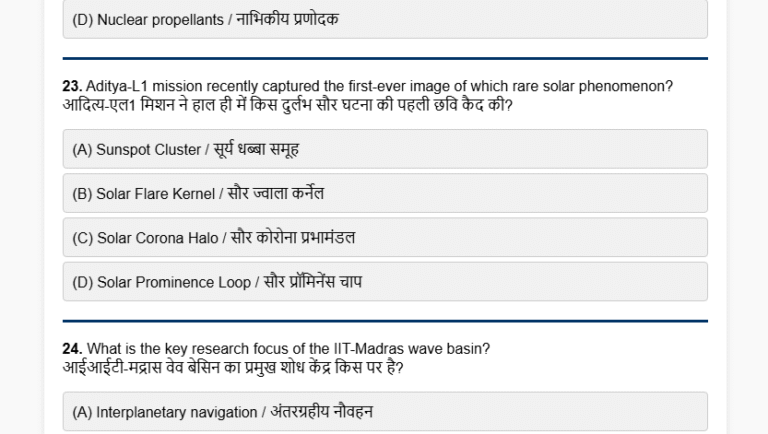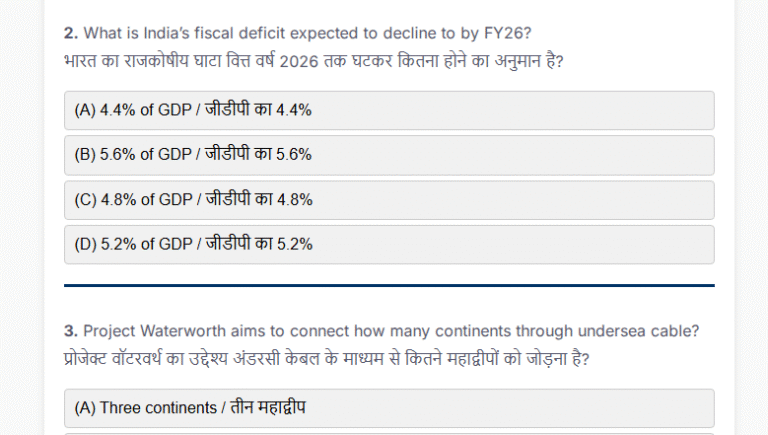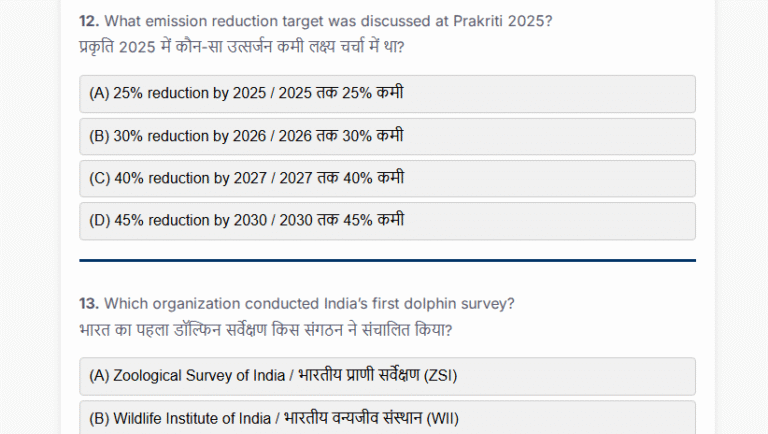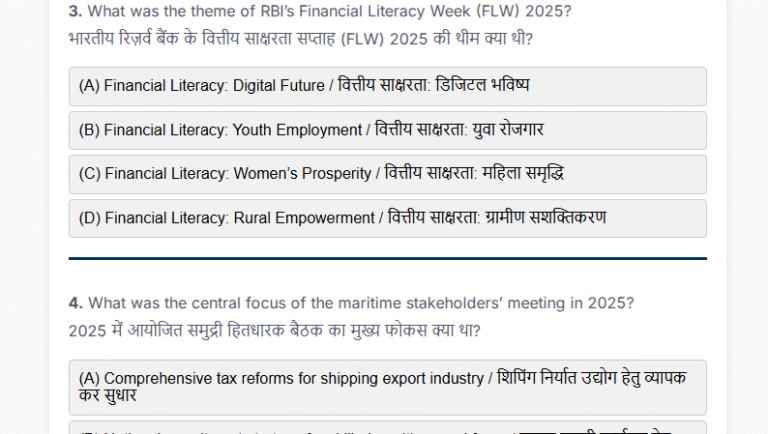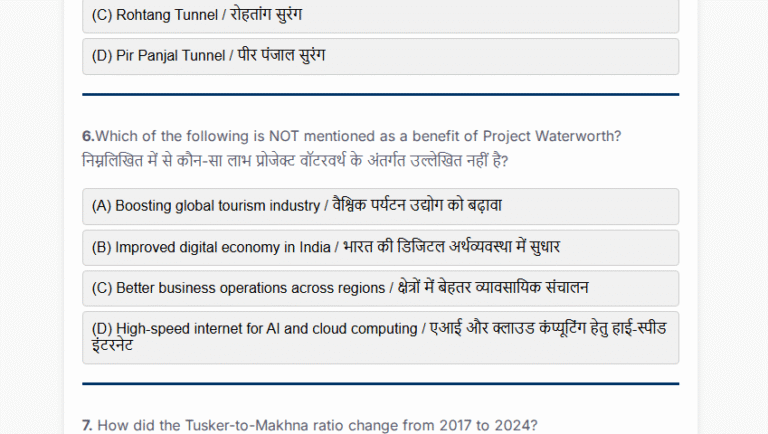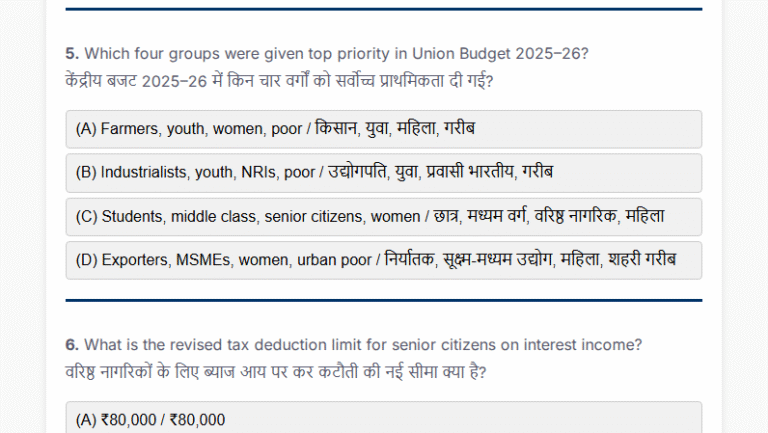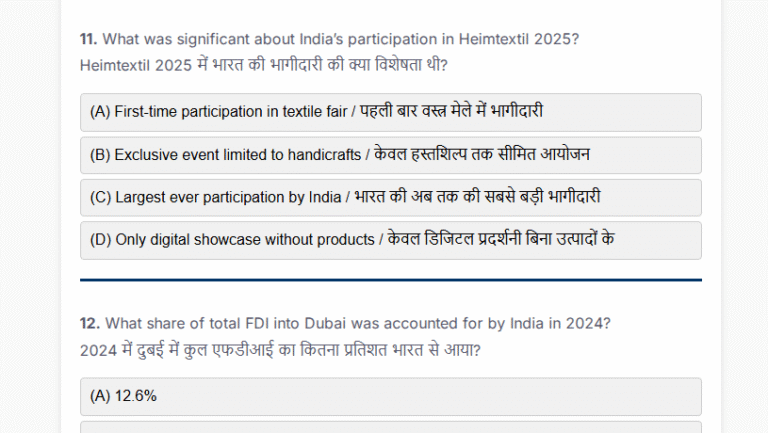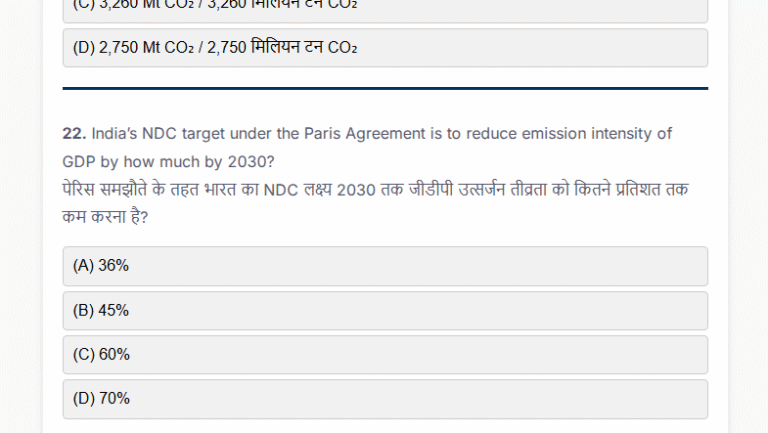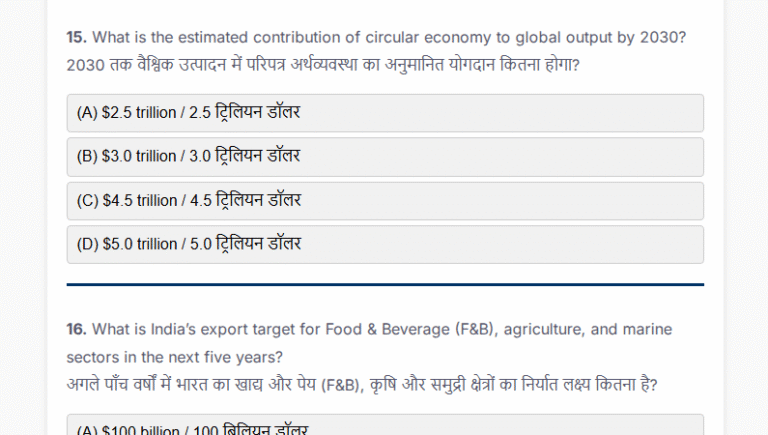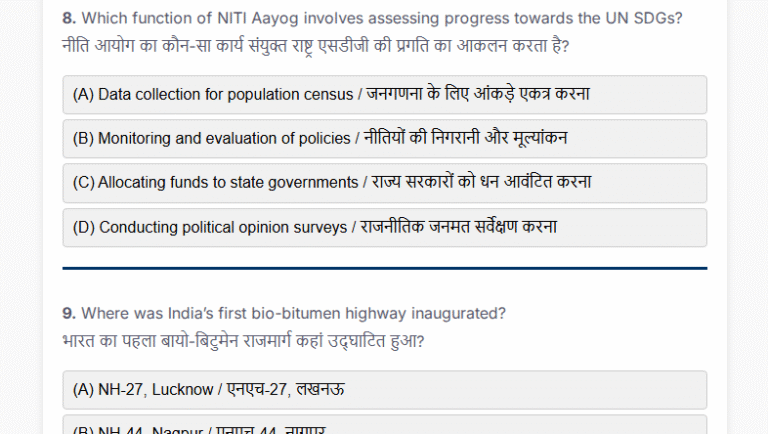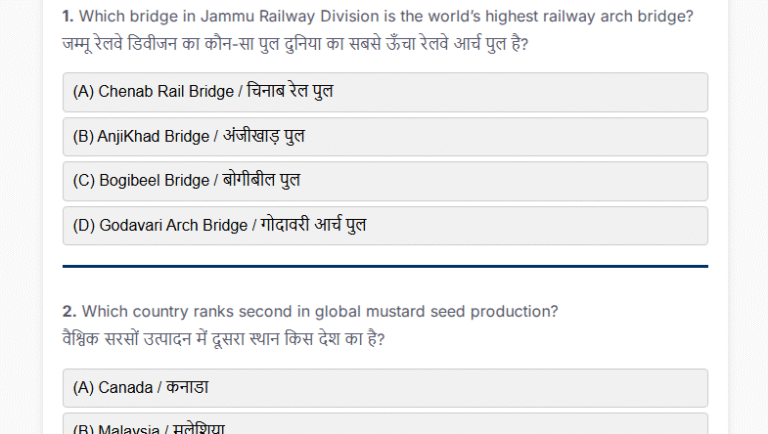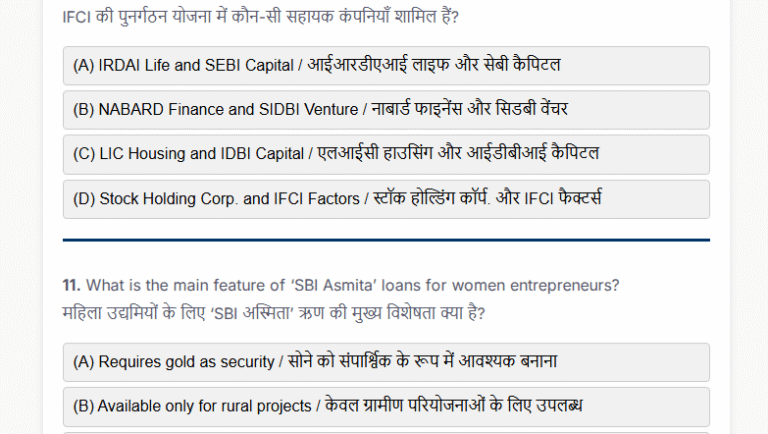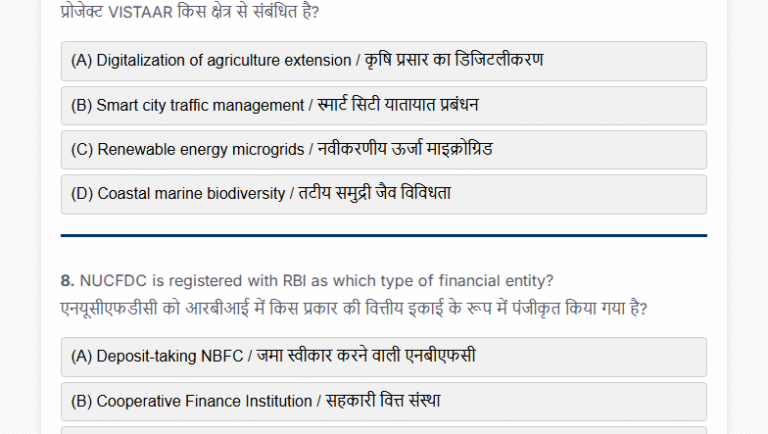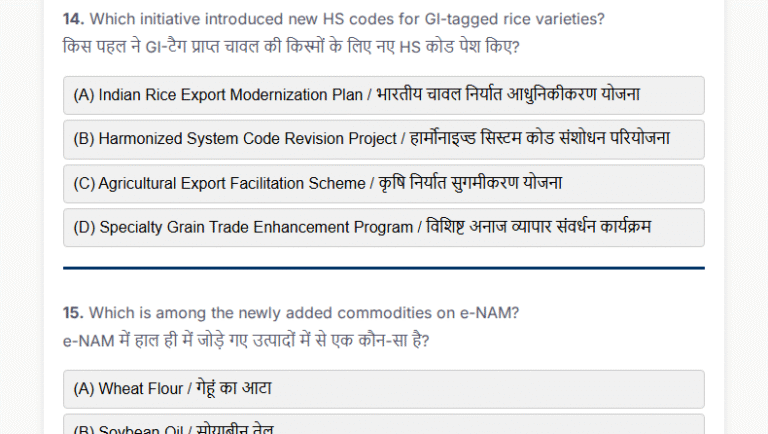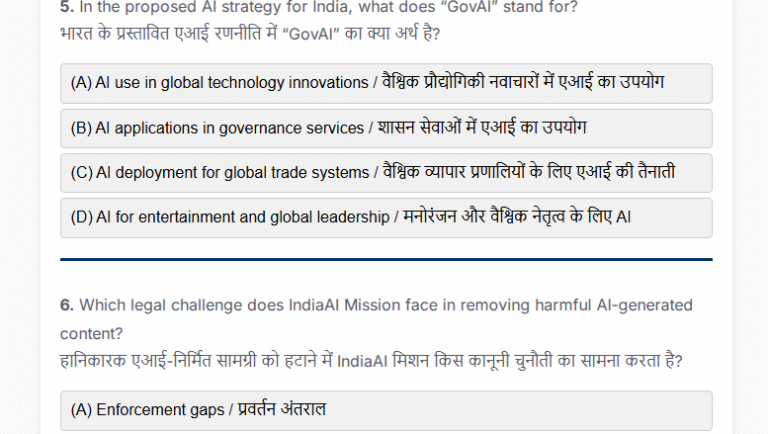Current Affairs Today MCQs 9 Nov 2024
1. The International Seabed Authority (ISA) was established under which international agreement?
(A) Treaty on the Non-Proliferation of Nuclear Weapons
(B) United Nations Convention on the Law of the Sea (UNCLOS)
(C) Paris Agreement on Climate Change
(D) International Maritime Treaty
The correct answer is (B) United Nations Convention on the Law of the Sea (UNCLOS)
The International Seabed Authority (ISA) was established in 1994 under the United Nations Convention on the Law of the Sea (UNCLOS) and the 1994 Agreement for implementing Part XI. ISA, headquartered in Kingston, Jamaica, is responsible for regulating mineral activities on the international seabed, beyond national boundaries, to ensure environmental protection and benefits for humankind. It operates within UNCLOS’s framework, which governs rights and responsibilities concerning ocean resources and environmental preservation.
2. What is the primary purpose of the International Seabed Authority (ISA)?
(A) Regulating fishing activities in international waters
(B) Overseeing mineral-related activities in the international seabed area
(C) Promoting maritime trade between nations
(D) Enforcing international military treaties
The correct answer is (B) Overseeing mineral-related activities in the international seabed area
The ISA’s primary mandate is to regulate mineral exploration and mining activities in “the Area”—the international seabed beyond national jurisdictions. This region, covering roughly 50% of the world’s ocean floor, is regulated by ISA to ensure that any activities benefit humanity and minimize environmental impacts. It operates under the principle that the seabed and its resources are a “common heritage of mankind,” ensuring equitable access and protection.
3. Which of the following countries is NOT part of the 170 members of the International Seabed Authority as of 2024?
(A) United States
(B) India
(C) France
(D) Japan
The correct answer is (A) United States
While 170 entities, including 169 countries and the European Union, are members of the ISA, the United States is notably absent. The ISA membership includes all state parties to UNCLOS, but the U.S. has not ratified UNCLOS, despite being a significant maritime power. Consequently, the U.S. does not participate in ISA’s regulatory and decision-making processes, which are important for activities in international seabed areas.
4. Where is the Chabahar Port located?
(A) Along the Persian Gulf coast of Iran
(B) On the Gulf of Oman, Iran
(C) On the Arabian Sea, Pakistan
(D) On the Caspian Sea, Turkmenistan
The correct answer is (B) On the Gulf of Oman, Iran
Chabahar Port is situated on the Makran Coast of Iran’s Sistan-Baluchistan province, along the Gulf of Oman, near the Strait of Hormuz. It is Iran’s only port with direct access to the Indian Ocean. Chabahar is crucial for India as a strategic trade route to Afghanistan and Central Asia, bypassing Pakistan. The port forms part of the International North-South Transport Corridor (INSTC), enhancing India’s connectivity to Eurasian markets.
5. The Chabahar Port is located approximately how many nautical miles from Mumbai, India?
(A) 550 nautical miles
(B) 786 nautical miles
(C) 450 nautical miles
(D) 1200 nautical miles
The correct answer is (B) 786 nautical miles
Chabahar Port is about 786 nautical miles from Mumbai, making it an accessible trade and strategic link for India. The proximity facilitates India’s access to Afghanistan and Central Asian markets, promoting regional connectivity. India’s investment and involvement in Chabahar align with its interests in the International North-South Transport Corridor (INSTC), supporting trade and commerce by connecting the Indian Ocean with Northern Europe through Iran.
6. The Asia Tea Alliance was formed to address which of the following challenges in the tea industry?
(A) Rising labor costs
(B) Climate change impacts on tea production
(C) Declining tea consumption globally
(D) Shortage of skilled tea workers
The correct answer is (B) Climate change impacts on tea production
The Asia Tea Alliance, a coalition of tea associations from leading tea-producing Asian countries like India, China, Sri Lanka, and Japan, was established to tackle challenges posed by climate change on tea production. It promotes sustainable practices, trade cooperation, and the collective interests of member nations. The alliance has taken a stance against genetically modified tea and focuses on adapting the industry to address environmental and economic impacts resulting from climate change.
7. Which of the following is NOT a requirement for tea cultivation in India?
(A) Frost-free climate
(B) High altitude
(C) Well-drained soil rich in organic matter
(D) Frequent showers throughout the year
The correct answer is (B) High altitude
Tea cultivation requires specific climate and soil conditions, such as a warm, frost-free climate, well-drained and fertile soil, and frequent rainfall distributed evenly over the year to support leaf growth. While tea does thrive in hilly regions like Darjeeling, high altitude is not an essential requirement for tea production. India’s tea-growing regions include states like Assam and Tamil Nadu, where conditions for tea are ideal, regardless of altitude
8. India is the largest producer of which type of tea?
(A) Green tea
(B) Oolong tea
(C) White tea
(D) Black tea
The correct answer is (D) Black tea
India is the largest producer of black tea globally and the second-largest overall tea producer after China. Indian black tea is known for its robust flavor and is a major export product, with destinations like Russia, Iran, and Iraq. Regions like Assam, Darjeeling, and Nilgiri are renowned for their distinctive varieties, and the Indian tea industry supports millions of workers directly and indirectly, contributing significantly to the economy.
9. Which of the following geographical conditions is ideal for tea production?
(A) Temperature between 25-30°C
(B) Rainfall above 300 cm annually
(C) Humus-rich, well-drained soil
(D) Frost-prone environment
The correct answer is (C) Humus-rich, well-drained soil
Tea plants require humus-rich, well-drained soil to thrive, which supports nutrient absorption and root development. Ideal conditions for tea production also include a warm, moist climate (without frost) and moderate rainfall of 150-200 cm annually, evenly distributed. These conditions enable continuous leaf growth and optimal flavor development. Indian states like Assam and West Bengal provide suitable climates and soils, making India one of the world’s top tea producers.
10. The International North-South Transport Corridor (INSTC), of which Chabahar Port is a part, connects which regions?
(A) The Indian Ocean to East Asia
(B) The Indian Ocean to Northern Europe
(C) Southeast Asia to South America
(D) The Indian Ocean to the Arctic
The correct answer is (B) The Indian Ocean to Northern Europe
The International North-South Transport Corridor (INSTC) is a multimodal transport project connecting the Indian Ocean to Northern Europe through Iran, Russia, and Central Asia. Chabahar Port plays a strategic role in this corridor by providing India with an alternative route to access Central Asia and beyond, bypassing Pakistan. This corridor enhances trade efficiency, reduces travel time, and strengthens economic and strategic ties between participating countries.
11. Under which agreement was Part XI of the United Nations Convention on the Law of the Sea (UNCLOS) implemented, leading to the establishment of the International Seabed Authority?
(A) 1994 Agreement
(B) 1992 Rio Declaration
(C) 1987 Montreal Protocol
(D) 1971 Ramsar Convention
The correct answer is (A) 1994 Agreement
The 1994 Agreement on the Implementation of Part XI of UNCLOS provided the legal foundation for the International Seabed Authority (ISA), regulating mineral exploration and mining activities in the international seabed area for humanity’s benefit. This agreement ensured fair distribution of marine resources beyond national jurisdictions, mandating ISA’s jurisdiction over nearly half of the world’s ocean floor.
12. Which of the following correctly describes Chabahar Port’s significance for India?
(A) Provides India direct access to the Atlantic Ocean
(B) Enhances India’s trade routes to Afghanistan and Central Asia
(C) Enables India to avoid maritime routes via the Persian Gulf
(D) Links India directly to China’s Belt and Road Initiative (BRI)
The correct answer is (B) Enhances India’s trade routes to Afghanistan and Central Asia
Chabahar Port, located on the Makran Coast of Iran along the Gulf of Oman, provides India a strategic trade route to Afghanistan and Central Asia, bypassing Pakistan. India’s involvement in developing this port facilitates trade via the International North-South Transport Corridor (INSTC), improving regional connectivity and aligning with India’s geopolitical interests in Central Asia.
13. As of 2024, which of the following regions accounts for the highest tea production in India?
(A) Tamil Nadu
(B) Kerala
(C) Assam
(D) West Bengal
The correct answer is (C) Assam
Assam is the leading tea-producing region in India, accounting for approximately 55% of the nation’s total tea output. The state’s fertile soil, high rainfall, and warm, humid climate make it ideal for tea cultivation. Indian teas, particularly Assam and Darjeeling varieties, are globally renowned and play a vital role in India’s economy and exports.
14. The Asia Tea Alliance was formed with the aim to:
(A) Support genetically modified tea to increase productivity
(B) Address climate change and promote sustainable practices
(C) Enhance tea tourism in Asia
(D) Reduce competition among Asian tea producers
The correct answer is (B) Address climate change and promote sustainable practices
The Uttarakhand Livability Improvement Project, funded by a $200 million loan from the Asian Development Bank (ADB), focuses on improving infrastructure in five cities: Haldwani, Champawat, Kichha, Kotdwar, and Vikasnagar. The project aims to enhance urban livability by upgrading roads, traffic management, flood management, and water supply systems. Rishikesh is not included in this project. This initiative aligns with India’s commitment to improve urban infrastructure, especially in ecologically sensitive regions like Uttarakhand, ensuring sustainable development and better quality of life for residents.
15. What is the minimum annual rainfall requirement for optimal tea cultivation?
(A) 100-120 cm
(B) 130-150 cm
(C) 150-200 cm
(D) 200-250 cm
The correct answer is (C) 150-200 cm
Tea cultivation requires a warm, humid climate with a minimum annual rainfall of 150-200 cm, which should be well-distributed throughout the year. This consistent rainfall promotes continuous growth of the tender tea leaves necessary for high-quality tea production. Such climatic conditions are found in regions like Assam, West Bengal, and Tamil Nadu in India.
16. Which country is the largest black tea producer in the world?
(A) China
(B) Sri Lanka
(C) Kenya
(D) India
The correct answer is (D) India
India is the largest producer of black tea worldwide. With its distinctive varieties like Assam, Darjeeling, and Nilgiri, Indian black teas are highly sought after internationally. India’s tea production contributes significantly to global black tea exports, making it a vital component of the Indian economy.
17. The International North-South Transport Corridor (INSTC) involves which modes of transport?
(A) Only maritime routes
(B) Only rail and road routes
(C) Multimodal transport (sea, rail, and road)
(D) Only air and rail routes
The correct answer is (C) Multimodal transport (sea, rail, and road)
The INSTC is a multimodal transport project that includes sea, rail, and road routes to facilitate trade between India, Iran, Russia, and Northern Europe. By linking the Indian Ocean to Europe, INSTC aims to improve trade connectivity, reduce travel time, and enhance economic cooperation among member nations, with Chabahar Port playing a key role.
18. Which state in India is closest to Chabahar Port in terms of nautical miles?
(A) Tamil Nadu
(B) Gujarat
(C) Maharashtra
(D) Kerala
The correct answer is (B) Gujarat
Gujarat, specifically Kandla Port, is the Indian state closest to Chabahar Port, with a distance of about 550 nautical miles. This proximity makes Chabahar an essential link for India’s trade route to Afghanistan and Central Asia, bypassing Pakistan and enhancing India’s connectivity with the region.
19. Which organization is headquartered in Kingston, Jamaica, and focuses on regulating activities in the international seabed?
(A) United Nations Environment Programme (UNEP)
(B) International Seabed Authority (ISA)
(C) International Maritime Organization (IMO)
(D) International Union for Conservation of Nature (IUCN)
The correct answer is (B) International Seabed Authority (ISA)
The International Seabed Authority (ISA) is headquartered in Kingston, Jamaica, and is tasked with regulating mineral exploration and mining in “the Area”—the international seabed beyond national jurisdictions. ISA ensures these activities are environmentally responsible and that benefits are distributed equitably under the principle that seabed resources are a “common heritage of mankind.”
20. The ideal temperature range for tea cultivation in India is:
(A) 5-10°C
(B) 10-15°C
(C) 15-23°C
(D) 25-30°C
The correct answer is (C) 15-23°C
Tea plants thrive in a warm and humid climate with temperatures between 15-23°C. This range, combined with fertile, well-drained soil and regular rainfall, provides optimal conditions for the growth of tender tea leaves. This climate is available in regions like Assam, West Bengal, and Tamil Nadu, which are India’s main tea-producing areas.
Source:- International Seabed Authority (ISA)
_
Set 20 Quarterly CA 2025 Jan to March IMPORTANT INSTRUCTIONS This test consists of 25 questions.At…
Set 19 Quarterly CA 2025 Jan to March IMPORTANT INSTRUCTIONS This test consists of 25 questions.At…
Set 18 Quarterly CA 2025 Jan to March IMPORTANT INSTRUCTIONS This test consists of 25 questions.At…
Set 17 Quarterly CA 2025 Jan to March IMPORTANT INSTRUCTIONS This test consists of 25 questions.At…
Set 16 Quarterly CA 2025 Jan to March IMPORTANT INSTRUCTIONS This test consists of 25 questions.At…
Set 15 Quarterly CA 2025 Jan to March IMPORTANT INSTRUCTIONS This test consists of 25 questions.At…
Set 14 Quarterly CA 2025 Jan to March IMPORTANT INSTRUCTIONS This test consists of 25 questions.At…
Set 13 Quarterly CA 2025 Jan to March IMPORTANT INSTRUCTIONS This test consists of 25 questions.At…
Set 12 Quarterly CA 2025 Jan to March IMPORTANT INSTRUCTIONS This test consists of 25 questions.At…
Set 11 Quarterly CA 2025 Jan to March IMPORTANT INSTRUCTIONS This test consists of 25 questions.At…
Set 10 Quarterly CA 2025 Jan to March IMPORTANT INSTRUCTIONS This test consists of 25 questions.At…
Set 9 Quarterly CA 2025 Jan to March IMPORTANT INSTRUCTIONS This test consists of 25 questions.At…
Set 8 Quarterly CA 2025 Jan to March IMPORTANT INSTRUCTIONS This test consists of 25 questions.At…
Set 7 Quarterly CA 2025 Jan to March IMPORTANT INSTRUCTIONS This test consists of 25 questions.At…
Set 6 Quarterly CA 2025 Jan to March IMPORTANT INSTRUCTIONS This test consists of 25 questions.At…
Set 5 Quarterly CA 2025 Jan to March IMPORTANT INSTRUCTIONS This test consists of 25 questions.At…
Set 4 Quarterly CA 2025 Jan to March IMPORTANT INSTRUCTIONS This test consists of 25 questions.At…
Set 2 Quarterly CA 2025 Jan to March IMPORTANT INSTRUCTIONS This test consists of 25 questions.At…
Set 3 Quarterly CA 2025 Jan to March IMPORTANT INSTRUCTIONS This test consists of 25 questions.At…
Test Series of 1st Quarterly Current Affairs 2025 प्रथम त्रैमासिक करेंट अफेयर्स 2025 की टेस्ट सीरीज़…
Current Affairs Today MCQs (26 Nov 2024) 1. What is the primary purpose of the Rejang Dewa dance in…
Current Affairs Today MCQs (25 Nov 2024) 1. What feature distinguishes African penguins from other…
Current Affairs Today MCQs (24 Nov 2024) 1. Which of the following is a distinctive feature of…
Current Affairs Today MCQs (23 Nov 2024) 1. What is the target adaptation finance commitment for the…
Current Affairs Today MCQs (22 Nov 2024) 1. How many youth are targeted for internships under the PM…
Current Affairs Today MCQs (21 Nov 2024) 1. Which is the funding ratio for PM-JAY between the Centre…
Current Affairs Today MCQs (20 Nov 2024) 1. Who is eligible for the Ayushman Vay Vandana Card? (A)…
Current Affairs Today MCQs (5 Nov 2024) 1. What conditions contribute to the formation of the DANA…
Current Affairs Today MCQs (4 Nov 2024) 1. What is the primary function of Israel’s Iron Beam…
Current Affairs Today MCQs (3 Nov 2024) 1. To whom was the Balfour Declaration addressed? (A) David…


